Effect of material treatment methods on recovery yield, quality parameters and antimicrobial activities of essential oil obtained from turmeric leaf using hydrodistillation
Bạn đang xem bản rút gọn của tài liệu. Xem và tải ngay bản đầy đủ của tài liệu tại đây (9.86 MB, 117 trang )
MINISTRY OF EDUCATION AND TRAINING
HO CHI MINH CITY UNIVERSITY OF TECHNOLOGY AND EDUCATION
FACULTY FOR HIGH QUALITY TRAINING
GRADUATION THESIS
FOOD TECHNOLOGY
EFFECT OF MATERIAL TREATMENT METHODS ON
RECOVERY YIELD, QUALITY PARAMETERS AND
ANTIMICROBIAL ACTIVITIES OF ESSENTIAL OIL
OBTAINED FROM TURMERIC LEAF USING
HYDRODISTILLATION
ADVISOR: HOANG VAN CHUYEN
STUDENT: NGUYEN THI QUYNH HUONG
LE THI CAM NHUNG
SKL 0 0 8 9 4 0
Ho Chi Minh City, August, 2022
HO CHI MINH CITY UNIVERSITY OF TECHNOLOGY AND EDUCATION
FACULTY FOR HIGH QUALITY TRAINING
GRADUATION PROJECT
Thesis code: 2022-18116019
EFFECT OF MATERIAL TREATMENT METHODS ON
RECOVERY YIELD, QUALITY PARAMETERS AND
ANTIMICROBIAL ACTIVITIES OF ESSENTIAL OIL
OBTAINED FROM TURMERIC LEAF USING
HYDRODISTILLATION
NGUYEN THI QUYNH HUONG
Student ID: 18116019
LE THI CAM NHUNG
Student ID: 18116026
Major: FOOD TECHNOLOGY
ADVISOR: HOANG VAN CHUYEN, PhD.
Ho Chi Minh City, August 2022
HO CHI MINH CITY UNIVERSITY OF TECHNOLOGY AND EDUCATION
FACULTY FOR HIGH QUALITY TRAINING
GRADUATION PROJECT
Thesis code: 2022-18116019
EFFECT OF MATERIAL TREATMENT METHODS ON
RECOVERY YIELD, QUALITY PARAMETERS AND
ANTIMICROBIAL ACTIVITIES OF ESSENTIAL OIL
OBTAINED FROM TURMERIC LEAF USING
HYDRODISTILLATION
NGUYEN THI QUYNH HUONG
Student ID: 18116019
LE THI CAM NHUNG
Student ID: 18116026
Major: FOOD TECHNOLOGY
ADVISOR: HOANG VAN CHUYEN, PhD.
Ho Chi Minh City, August 2022
ii
ACKNOWLEDGEMENTS
We would like to express our very great appreciation to all of the lectures at Ho Chi Minh
City University of Technology and Education in general and lecturers at the Faculty of Chemical
and Food Technology especially. We gained valuable knowledge and skills regarding Food
Technology throughout our four years at the school.
This paper and the research behind it would not have been possible without the exceptional
support of my supervisor, Dr. Hoang Van Chuyen - lecturer at the Department of Food
Technology, Faculty of Chemical and Food Technology, Ho Chi Minh University of Technology
and Education. From the initial concept to the final graduation thesis, he was always enthusiastic
in his support, mentoring, and imparting knowledge and experience. We are truly grateful, and
we will remember everything forever.
A special thanks goes out to consultants Ho Thi Thu Trang and Nguyen Thi My Le, who are
in charge of the Department of Food Technology laboratories and Chemical Laboratories
respectively. Their cooperation and assistance with tools, machines, and equipment was greatly
appreciated during the course of our investigation. Thanks to the professors in Food Technology
Workshop 1, Microbiology Laboratory, Biochemistry Laboratory, and the Sensory Lab for
providing a conducive environment in which to accomplish our thesis, we are also expressing
sincere gratitude to them.
Finally, we would like to thank our family and friends, who have supported us throughout the
process of making this thesis.
Since our professional knowledge and practical experience are still limited, the report
inevitably has shortcomings, we look forward to receiving your comments to make this report
more complete.
Thank you sincerely!
iii
DISCLAIMER
We hereby declare that all the content presented in the graduation thesis was written by us
with the guidance Ph.D Hoang Van Chuyen. We also hereby certify that the contents referenced
in the graduation thesis have been correctly and fully cited in accordance with regulations.
Ho Chi Minh City, August 9, 2022
Authors
Nguyen Thi Quynh Huong
Le Thi Cam Nhung
iv
TABLE OF CONTENTS
ACKNOWLEDGEMENTS........................................................................................................... iii
DISCLAIMER ................................................................................................................................iv
LIST OF FIGURES ........................................................................................................................ix
LIST OF TABLES........................................................................................................................... x
LIST OF ACRONYMS ..................................................................................................................xi
ABSTRACT ................................................................................................................................. xii
Chapter 1: INTRODUCTION ................................................................................................... 1
1.1.
Introduction .......................................................................................................................... 1
1.2.
Research content ................................................................................................................... 1
1.3.
Research aims ....................................................................................................................... 2
1.4.
Overall experimental design of the project ........................................................................... 2
1.5.
Research hypotheses ............................................................................................................. 2
Chapter 2: LITERATURE REVIEW.......................................................................................... 4
2.1.
Overview of turmeric and turmeric leaves ........................................................................... 4
2.1.1.
Origin ............................................................................................................................ 4
2.1.2.
Characteristic ................................................................................................................. 4
2.1.3.
Chemical composition and application ......................................................................... 8
2.2.
2.1.3.1.
Chemical composition ........................................................................................... 8
2.1.3.2.
Nutritional value .................................................................................................. 10
2.1.3.3.
Application ........................................................................................................... 10
Overview of essential oils................................................................................................... 12
2.2.1.
Definition .................................................................................................................... 12
2.2.2.
Origin and development of essential oils .................................................................... 13
2.2.3.
Physical properties and chemical compositions of essential oils ................................ 13
2.2.3.1.
Physical properties ............................................................................................... 14
2.2.3.2.
Chemical compositions ........................................................................................ 14
2.2.4.
2.3.
Applications of essential oils....................................................................................... 17
Techniques for recovering essential oils ............................................................................ 18
2.3.1.
Distillation methods .................................................................................................... 18
2.3.1.1.
Hydro-distillation (HD) ....................................................................................... 18
2.3.1.2.
Water-steam distillation ....................................................................................... 18
2.3.1.3.
Steam distillation (SD)......................................................................................... 19
2.3.2.
Solvent extraction ........................................................................................................ 19
2.3.3.
Cold pressing ............................................................................................................... 20
v
2.3.4.
Soxhlet extraction ........................................................................................................ 21
2.3.5.
New methods in essential oil extraction ...................................................................... 22
2.3.5.1.
Microwave-Assisted Hydro-distillation (MAHD) ............................................... 22
2.3.5.2.
Ultrasound-Assisted extraction (UAE) ................................................................ 23
2.3.5.3.
Supercritical Fluid Extraction (SFE) ................................................................... 23
2.4.2.
2.5.
The main influencing factors in steam distillation ...................................................... 25
2.4.2.1.
Diffusion .............................................................................................................. 25
2.4.2.2.
Hydrolysis ............................................................................................................ 26
2.4.2.3.
Temperature ......................................................................................................... 26
2.4.2.4.
Advantages and disadvantages ............................................................................ 26
Introduction to gas chromatography with mass spectrometry (GC/MS) ............................ 27
2.5.1.
Gas Chromatography (GC) ......................................................................................... 27
2.5.2.
Mass Spectrometry (MS) ............................................................................................ 28
2.5.3.
Gas chromatography with mass spectrometry (GC–MS) ........................................... 28
2.6.
A brief overview of pathogenic microorganisms in the research ....................................... 28
2.6.1.
Staphylococcus aureus ................................................................................................ 28
2.6.2.
Escherichia coli ........................................................................................................... 29
2.7.
Research situation of turmeric leaf essential oil ................................................................. 31
2.7.1.
Domestic studies on turmeric leaf essential oil ........................................................... 31
2.7.2.
Overseas studies on turmeric leaf essential oil ............................................................ 31
2.7.2.1.
Constituents of the Leaf Oil of Curcuma longa L. from Uttaranchal .................. 31
2.7.2.2. Chemical composition and antifungal activity of oil extracted from turmeric
leaves (Curcuma longa L.)..................................................................................................... 31
Chapter 3: RESEARCH MATERIALS AND METHODS ................................................... 33
3.1.
Plant material ...................................................................................................................... 33
3.2.
Tools, equipment, chemical substances .............................................................................. 33
3.2.1.
Tools, equipment ......................................................................................................... 33
3.2.2.
Chemical substances ................................................................................................... 33
3.3.
Research diagram ............................................................................................................... 34
3.4.
Research methods ............................................................................................................... 34
3.4.1.
Experimental design .................................................................................................... 34
3.4.2.
Analytical methods ...................................................................................................... 36
3.4.2.1.
Determination of total essential oil content in the material ................................. 36
3.4.2.2.
Analysis of physicochemical quality ................................................................... 37
3.4.2.3.
Analysis of chemical composition ....................................................................... 39
3.4.2.4.
Sensory evaluation ............................................................................................... 39
3.4.2.5.
Analysis of antimicrobial activity ........................................................................ 40
vi
3.4.3.
Statistical analysis ....................................................................................................... 41
Chapter 4: EXPERIMENT RESULTS/ FINDINGS AND ANALYSIS .............................. 42
4.1. Effect of time, leave sizes, pre-treatment of leaves on essential oil content during
distillation ...................................................................................................................................... 42
4.1.1.
Effect of different time on essential oils content during distillation ........................... 42
4.1.3.
Effect of different time of pre-treatment on essential oils content during distillation 44
4.1.3.1. Effect of different time of Steam pre-treatment on essential oils content during
distillation .............................................................................................................................. 44
4.1.3.2. Effect of different time of Ultrasound pre-treatment on essential oils content
during distillation ................................................................................................................... 44
4.1.3.3. Effect of different time of Microwave pre-treatment on essential oils content
during distillation ................................................................................................................... 46
4.2.
Total essential oils content in the material ......................................................................... 46
4.3.
Physicochemical quality ..................................................................................................... 47
4.3.1. Effect of different pre-treatments of leaves on color characteristic of essential oils
from turmeric leaves .................................................................................................................. 47
4.3.2.
leaves
Effect of different pre-treatments of leaves on density of essential oils from turmeric
..................................................................................................................................... 48
4.3.3. Effect of different pre-treatments of leaves on viscosity of essential oils from
turmeric leaves ........................................................................................................................... 49
4.3.4. Effect of different pre-treatments of leaves on acidity index of essential oils from
turmeric leaves ........................................................................................................................... 50
4.3.5. Effect of different pre-treatments of leaves on saponification index of essential oils
from turmeric leaves .................................................................................................................. 51
4.3.6. Effect of different pre-treatments of leaves on ester index of essential oils from
turmeric leaves ........................................................................................................................... 52
4.4.
Sensory evaluation results .................................................................................................. 52
4.5.
Chemical compositions of turmeric leaf essential oil ......................................................... 53
4.6.
Antimicrobial activity ......................................................................................................... 54
4.6.1. Effect of turmeric leaf oil from different treatment methods at various concentrations
on the microorganism diameter of Staphlococcus areus during incubation .............................. 54
4.6.2. Effect of turmeric leaf oil from different treatment methods at various concentrations
on the microorganism diameter of Escherichia coli during incubation ..................................... 55
4.6.3. Effect of turmeric leaves oil concentration from different material treatment methods
on microorganism diameter of S. aureus and E.coli after 7 days of incubation ........................ 56
4.6.4. Effect of turmeric leaves oil concentration from different material treatment methods
on growth inhibition (%) of S. aureus and E.coli after 7 days of incubation. ........................... 57
4.6.5. Half maximal inhibitory concentration (IC50) of 4 different types of essential oil for
Staphylococcus aureus and Escherichia coli. ............................................................................ 59
Chapter 5: CONCLUSION AND RECOMMENDATIONS................................................. 60
5.1.
Conclusion .......................................................................................................................... 60
vii
5.2.
Recommendations .............................................................................................................. 60
REFERENCES .............................................................................................................................. 62
APPENDIX ................................................................................................................................... 71
viii
LIST OF FIGURES
Figure 1.1 The overall experimental design. ................................................................................... 2
Figure 2.1 (a) Whole plant, (b) rhizomes of C.longa. ..................................................................... 5
Figure 2.2 Curcuma alismatifolia. .................................................................................................. 6
Figure 2.3 Curcuma kwangsiensis. ................................................................................................. 6
Figure 2.4 Curcuma cochinchinensis. ............................................................................................. 7
Figure 2.5 Curcuma longa L. .......................................................................................................... 7
Figure 2.6 Curcuma zedoaria. ........................................................................................................ 8
Figure 2.7 Curcuma aromatic. ........................................................................................................ 8
Figure 2.8 Distribution of various compound types in Curcuma species. Data were obtained
from literature published in 1815–2014 (Sun et al., 2016). ............................................................ 9
Figure 2.9 Structural formula of demethoxycurcumin and bisdemethoxycurcumin. .................... 10
Figure 2.10 The schematic for Clevenger-type apparatus (S.H.Jain & G.Ravikumar, 2010). .... 18
Figure 2.11 The schematic apparatus for Steam distillation (Rassem et al., 2016). .................... 19
Figure 2.12 Extraction of essential oils with solvents ("A Comprehensive Guide to Essential Oil
Extraction Methods," 2017)........................................................................................................... 20
Figure 2.13 Cold pressing method (Rassem et al., 2016). ............................................................ 21
Figure 2.14 Soxhlet extraction (Rassem et al., 2016). .................................................................. 22
Figure 2.15 Microwave-assisted hydro-distillation (Rassem et al., 2016). .................................. 23
Figure 2.16 Supercritical Fluid Extraction (SFE) (Rassem et al., 2016). .................................... 24
Figure 2.17 Extraction of essential oils by steam distillation ("A Comprehensive Guide to
Essential Oil Extraction Methods," 2017). .................................................................................... 25
Figure 3.1 Diagram of the process of recovering turmeric leaf essential oil. .............................. 34
Figure 3.2 Experimental design for recovering turmeric essential oil. ........................................ 35
Figure 3.3 Pre-treatment leaves were investigated with different times. ...................................... 36
Figure 4.1 Effect of different time on essential oils content during distillation. ........................... 42
Figure 4.2. Effect of different leaf sizes on essential oils during distillation. ............................... 43
Figure 4.3 Effect of different time of Steam pre-treatment on essential oils content during
distillation. ..................................................................................................................................... 44
Figure 4.4 Effect of different time of Ultrasound pre-treatment on essential oils content during
distillation. ..................................................................................................................................... 45
Figure 4.5 Effect of different time of Microwave pre-treatment on essential oils content during
distillation. ..................................................................................................................................... 46
Figure 4.6 Effect of different pre-treatments of leaves on density of essential oils from turmeric
leaves. ............................................................................................................................................ 49
Figure 4.7 Effect of different pre-treatments of leaves on viscosity of essential oils from turmeric
leaves. ............................................................................................................................................ 50
Figure 4.8 The effect of turmeric leaves oil concentration from different material treatment
methods on microorganism diameter of S. aureus during 7 days of incubation. .......................... 54
Figure 4.9 The effect of turmeric leaves oil concentration from different material treatment
methods on microorganism diameter of E.coli during 7 days of incubation. ............................... 55
Figure 4.10 Half maximal inhibitory concentration (IC50) of 4 different types of essential oil for
Staphylococcus aureus and Escherichia coli. ............................................................................... 59
ix
LIST OF TABLES
Table 3.1 Tools and equipment used. ............................................................................................ 33
Table 3.2 Chemical substances and origin. ................................................................................... 34
Table 4.1 Total essential oils content in the material.................................................................... 47
Table 4.2 Effect of different pre-treatments of leaves on color characteristic of essential oils from
turmeric leaves. ............................................................................................................................. 47
Table 4.3 Effect of different pre-treatments of leaves on acidity index of essential oils from
turmeric leaves. ............................................................................................................................. 51
Table 4.4 Effect of different pre-treatments of leaves on saponification index of essential oils
from turmeric leaves ...................................................................................................................... 51
Table 4.5 Effect of different pre-treatments of leaves on ester index of essential oils from
turmeric leaves. ............................................................................................................................. 52
Table 4.6 Hedonic scale sensory evaluation results...................................................................... 52
Table 4.7 Main component of turmeric leaf essential oil with ultrasound pretreatment and no
pretrearment. ................................................................................................................................. 54
Table 4.8 The effect of turmeric leaves oil concentration from different material treatment
methods on microorganism diameter of S. aureus and E.coli after 7 days of incubation. ............ 56
Table 4.9 The effect of turmeric leaves oil concentration from different material treatment
methods on growth inhibition (%) of S. aureus and E.coli after 7 days of incubation. ................ 57
x
LIST OF ACRONYMS
Ec
Escherichia coli
EO
Essential oil
GC-MS
Gas Chromatography–Mass Spectrometry
HD
Hydro-distillation
MAHD
Microwave-Assisted Hydro-distillation
MP
Microwave pretreatment
Sa
Staphylococcus aureus
SD
Steam distillation
SFE
Supercritical Fluid Extraction
SP
Steam pretreatment
UAE
Ultrasound-Assisted extraction
UP
Ultrasound pretreatment
xi
ABSTRACT
Essential oil was extracted from the turmeric leaf of six size namely 1mm, 5mm, 10mm, 15
mm, 20mm, whole leave and three pretreatments namely steaming, ultrasound treating,
microwaving using Clevenger apparatus. All the four species yielded significantly different
essential oil. The mean essential oil content of 0.450, 0.413, 0.367, 0.353, 0.310 and 0.343 (ml)
was obtained from 1mm, 5mm, 10mm, 15 mm, 20mm, whole leave, respectively. Particle size of
leaf was found to have significant influence on oil yield. The highest mean essential oil content
of 0.483, 0.500 and 0.487 was obtained from steaming, ultrasound treating, microwaving,
respectively. The GC-MS analysis for composition of the essential oils found 44 and 36 volatile
compounds in the essential oils from non-treated and ultrasound-treated leaves, respectively. In
addition, α - Phellandrene was found as the most dominant compound in the essential oil samples
(45.6-51.9%) followed by α-Terpinolene (9.5-11.9%) and Eucalyptol (8%). Thus the use of
ultrasound treating not only affected the antimicrobial activity but also impacted the composition
of essential oil from turmeric leaves.
Keyword: Essential oil, turmeric leave, pretreatment, steam distillation, antimicrobial.
xii
Chapter 1: INTRODUCTION
1.1.
Introduction
Turmeric (Curcuma longa L.) is a plant that has been grown very popular in Vietnam and
some Asian countries for a long time to be used as a medicine and also in food. The rhizome of
the turmeric plant has been utilized as a material for functional foods; however, other
components of the plant, such as the leaves, which are typically discarded as a waste product,
have their own unique applications due to the presence of curcumin and other bioactive
components. Furthermore, turmeric leaves have a huge volume and surface area, both of which
contribute to the plant's exceptional value for use in industrial applications as a rich source of
food (Choi & Lee., 2014). Studies have been conducted to explore the physicochemical
properties of the turmeric leaf extract in order to illustrate the extract's functional effects, which
include whitening, cosmeceutical, skin immunity, anti-inflammatory, and antioxidant activities
(Kim, Lim, & Lee., 2014). These effects are mostly caused by curcumin, which is found in
turmeric leaves, as well as phenolic chemicals and flavonoids.
In Vietnam, although there have been many studies related to the extraction of active
ingredients from turmeric rhizome, there has been no research on extraction of the beneficial
compounds from turmeric leaves. Therefore, after harvesting turmeric, almost all the leaves are
discarded. Turmeric leaves are not employed in industrial domains despite their functional
characteristics due to a lack of safety and legal basis and turmeric leaf research is poor and
restricted to explain their properties and functions. Because of these factors, turmeric leaves are
only utilized as feed for stock in certain regions and disposed as a waste with vast disposal costs
(Choi & Lee., 2014). Thus, if actively researching to discover and use new materials from
turmeric leaves, a source of waste, is considered as a driving force for the development of new
industries with high added value. From that, investigating the effects of extraction in order to
determine the appropriate parameters to increase the yield of essential oil, increase the quality of
essential oils and produce products with high biological activity is very urgent.
In this study, the effect of leaf size, extraction time and different pre-treatment methods of
leaves on the extraction efficiency of essential oil, color characteristic, viscosity, density, sensory
and antibacterial activity from essential oil of turmeric leaves were investigated to provide
suitable parameters that can be applied to improve the production efficiency of related products.
1.2.
Research content
The research content is classified into three major parts as shown below:
-
Recovering of fresh turmeric leaves by hydrodistillation to prepare essential oils.
-
Investigating factors affecting the yield and quality of the essential oil from turmeric
leaves using hydrodistillation.
-
Analyzing physicochemical properties, chemical composition, sensory properties and
antimicrobial activity of essential oil from turmeric leaves.
1

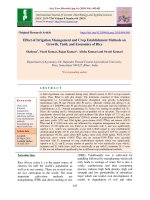
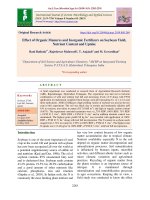
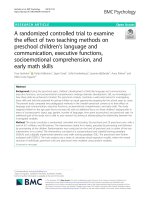
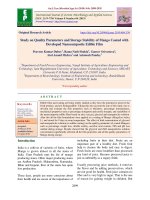
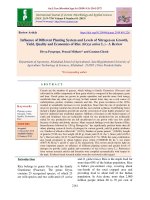
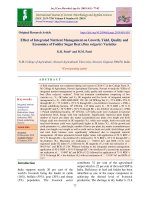
![Effect of substrate treatment methods on blue oyster mushroom [Hypsizygus ulmarius (Bull.: Fr.) Redhead] production](https://media.store123doc.com/images/document/2020_05/14/medium_jzg1589475292.jpg)

